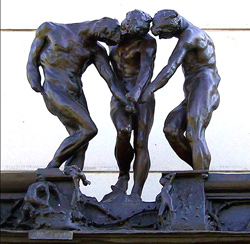Cantor Expands Rodin Galleries
 Auguste Rodin, The Gates of Hell (detail) The Three Shades, 1880-c. 1900. Bronze, cast 1981, no. 5
Auguste Rodin, The Gates of Hell (detail) The Three Shades, 1880-c. 1900. Bronze, cast 1981, no. 5The Cantor Arts Center at Stanford University recently announced the opening of its newly expanded Rodin galleries. On February 18, 2009, the Center's entire collection of works in bronze, plaster, ceramic, stone, and wax by renowned French sculptor Auguste Rodin (1840-1917) reopened to the public and continues on view indefinitely. This is one of nine new exhibitions this year that focus on the Cantor Arts Center's rich and diverse collections.
In addition to approximately 200 works in three galleries dedicated to his work, including the monumental sculpture The Thinker , the Stanford campus boasts 20 major works in the Rodin Sculpture Garden, adjacent to the Center, plus the Burghers of Calais nearby on campus. This is the world's largest collection of Rodin's bronzes outside Paris. Admission is free to the museum, its 24 galleries, and sculpture garden.
"This collection is almost entirely a product of the extraordinary generosity of Iris and B. Gerald Cantor and their foundation. Its contents reflect the guidance of the late Stanford professor Albert Elsen, who was the foremost Rodin scholar of his generation. With this new installation, we are striving to fulfill the aspirations of these collaborators, who sought to create an effective teaching collection for the benefit of the Stanford community and all our visitors," said Bernard Barryte, curator of European art and manager of publications. "To achieve this, we've organized the display to highlight Rodin's working process and greatest accomplishments."
The installation clusters works associated with specific projects, such as The Gates of Hell, so visitors can see the sculptor's struggles to give shape to his ideas and how he reused and adapted compositional ideas in successive projects. Rodin explored various genres, including the portrait, and he pioneered the use of the partial figure, such as hands and feet, as independent vehicles for emotional expression. These works are grouped together as well. Works on paper will change, due to their sensitivity to light and the need to preserve them for future generations.
Resources:
Also in this Issue:
- Copper Weather Vanes: Then and Now
- Copper Moon Woodworks: Shedding New Light on Windowshutters
- Making Cents: The First Designs and Future of the Copper Cent
- Andy Brinkley: Fusing Nature into Metal
- Cantor Expands Rodin Galleries
